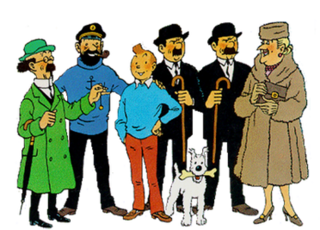
The Adventures of Tintin is a series of 24 comic albums created by Belgian cartoonist Georges Remi, who wrote under the pen name Hergé. The series was one of the most popular European comics of the 20th century. By 2007, a century after Hergé's birth in 1907, Tintin had been published in more than 70 languages with sales of more than 200 million copies, and had been adapted for radio, television, theatre, and film.

Cigars of the Pharaoh is the fourth volume of The Adventures of Tintin, the series of comic albums by Belgian cartoonist Hergé. Commissioned by the conservative Belgian newspaper Le Vingtième Siècle for its children's supplement Le Petit Vingtième, it was serialised weekly from December 1932 to February 1934. The story tells of young Belgian reporter Tintin and his dog Snowy, who are travelling in Egypt when they discover a pharaoh's tomb filled with dead Egyptologists and boxes of cigars. Pursuing the mystery of these cigars, they travel across Arabia and India, and reveal the secrets of an international drug smuggling enterprise.

Ligne claire is a style of drawing created and pioneered by Hergé, the Belgian cartoonist and creator of The Adventures of Tintin. It uses clear strong lines sometimes of varied width and no hatching, while contrast is downplayed as well. Cast shadows are often illuminated, and the style often features strong colours and a combination of cartoonish characters against a realistic background. The name was coined by Joost Swarte in 1977.

Tintin in America is the third volume of The Adventures of Tintin, the comics series by Belgian cartoonist Hergé. Commissioned by the conservative Belgian newspaper Le Vingtième Siècle for its children's supplement Le Petit Vingtième, it was serialized weekly from September 1931 to October 1932 before being published in a collected volume by Éditions du Petit Vingtième in 1932. The story tells of young Belgian reporter Tintin and his dog Snowy who travel to the United States, where Tintin reports on organized crime in Chicago. Pursuing a gangster across the country, he encounters a tribe of Blackfoot Native Americans before defeating the Chicago crime syndicate.
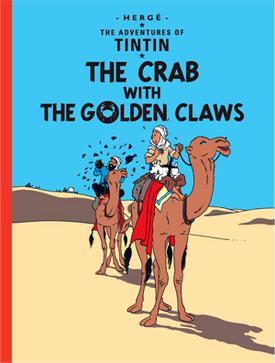
The Crab with the Golden Claws is the ninth volume of The Adventures of Tintin, the comics series by Belgian cartoonist Hergé. The story was serialised weekly in Le Soir Jeunesse, the children's supplement to Le Soir, Belgium's leading francophone newspaper, from October 1940 to October 1941 amidst the German occupation of Belgium during World War II. Partway through serialisation, Le Soir Jeunesse was cancelled and the story began to be serialised daily in the pages of Le Soir. The story tells of young Belgian reporter Tintin and his dog Snowy, who travel to Morocco to pursue a gang of international opium smugglers. The story marks the first appearance of main character Captain Haddock.

The Shooting Star is the tenth volume of The Adventures of Tintin, the comics series by Belgian cartoonist Hergé. The story was serialised daily in Le Soir, Belgium's leading francophone newspaper, from October 1941 to May 1942 amidst the German occupation of Belgium during World War II. The story tells of young Belgian reporter Tintin, who travels with his dog Snowy and friend Captain Haddock aboard a scientific expedition to the Arctic Ocean on an international race to find a meteorite that has fallen to the Earth.
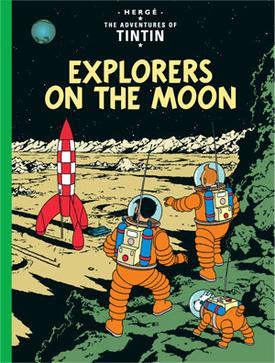
Explorers on the Moon is the seventeenth volume of The Adventures of Tintin, the comics series by Belgian cartoonist Hergé. The story was serialised weekly in Belgium's Tintin magazine from October 1952 to December 1953 before being published in a collected volume by Casterman in 1954. Completing a story arc begun in the preceding volume, Destination Moon (1953), the narrative tells of the young reporter Tintin, his dog Snowy, and friends Captain Haddock, Professor Calculus, and Thomson and Thompson who are aboard humanity's first crewed rocket mission to the Moon.
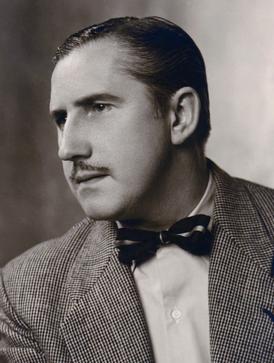
Edgard Félix Pierre Jacobs, better known under his pen name Edgar P. Jacobs, was a Belgian comic book creator, born in Brussels, Belgium. He was one of the founding fathers of the Franco-Belgian comics movement, through his collaborations with Hergé and the graphic novel series that made him famous, Blake and Mortimer.
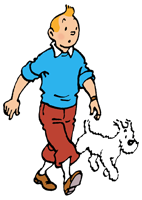
Tintin is the titular protagonist of The Adventures of Tintin, the comic series by Belgian cartoonist Hergé. The character was created in 1929 and introduced in Le Petit Vingtième, a weekly youth supplement to the Belgian newspaper Le Vingtième Siècle. Appearing as a young man with a round face and quiff hairstyle, Tintin is depicted as a precocious, multitalented reporter who travels the world with his dog Snowy.

Speech balloons are a graphic convention used most commonly in comic books, comics, and cartoons to allow words to be understood as representing a character's speech or thoughts. A formal distinction is often made between the balloon that indicates speech and the one that indicates thoughts; the balloon that conveys thoughts is often referred to as a thought bubble or conversation cloud.
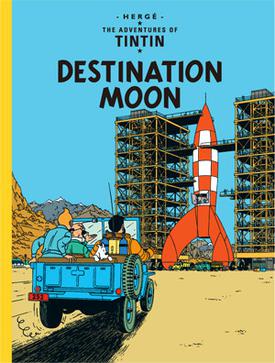
Destination Moon is the sixteenth volume of The Adventures of Tintin, the comics series by Belgian cartoonist Hergé. The story was initially serialised weekly in Belgium's Tintin magazine from March to September 1950 and April to October 1952 before being published in a collected volume by Casterman in 1953. The plot tells of young reporter Tintin and his friend Captain Haddock who receive an invitation from Professor Calculus to come to Syldavia, where Calculus is working on a top-secret project in a secure government facility to plan a crewed mission to the Moon.

Jean-Claude Mézières was a French bandes dessinées artist and illustrator. Born in Paris and raised in nearby Saint-Mandé, he was introduced to drawing by his elder brother and influenced by comics artists such as Hergé, Andre Franquin and Morris and later by Jijé and Jack Davis. Educated at the École nationale supérieure des arts appliqués et des métiers d'art, he worked upon graduation as an illustrator for books and magazines as well as in advertising. A lifelong interest in the Wild West led him to travel to the United States in 1965 in search of adventure as a cowboy, an experience that would prove influential on his later work.

Hergé's Adventures of Tintin is the first animated television series based on Hergé's popular comic book series, The Adventures of Tintin. The series was produced by Belvision Studios and first aired in 1957. After two books were adapted in black and white, eight books were then adapted in colour, each serialised into a set of five-minute episodes, with 103 episodes produced.
Notable events of 1968 in comics.

"Husbands and Knives" is the seventh episode of the nineteenth season of the American animated television series The Simpsons. It first aired on the Fox network in the United States on November 18, 2007. It features guest appearances from Alan Moore, Art Spiegelman, and Dan Clowes as themselves and Jack Black as Milo. It was written by Matt Selman and directed by Nancy Kruse. The title is a reference to the Woody Allen film Husbands and Wives.
Notable events of 1946 in comics.

Raymond Leblanc was a Belgian comic book publisher, film director and film producer, best known for publishing works such as The Adventures of Tintin by Hergé and Blake and Mortimer by Edgar P. Jacobs. He debuted, published, and promoted many of the most famous Franco-Belgian comics. Leblanc and his two partners created Le Lombard publishing, Tintin magazine, PubliArt advertising agency, and Belvision Studios.
Hergé, the Belgian comics author best known for The Adventures of Tintin, also created a number of short-lived, lesser-known comic strips.

The Belgian Comic Strip Center is a museum in central Brussels, Belgium, dedicated to Belgian comics. It is located at 20, rue des Sables/Zandstraat, in an Art Nouveau building designed by Victor Horta, and can be accessed from Brussels-Congress railway station and Brussels-Central railway station.















